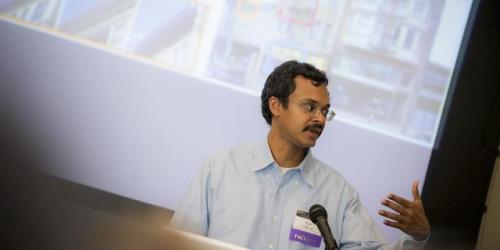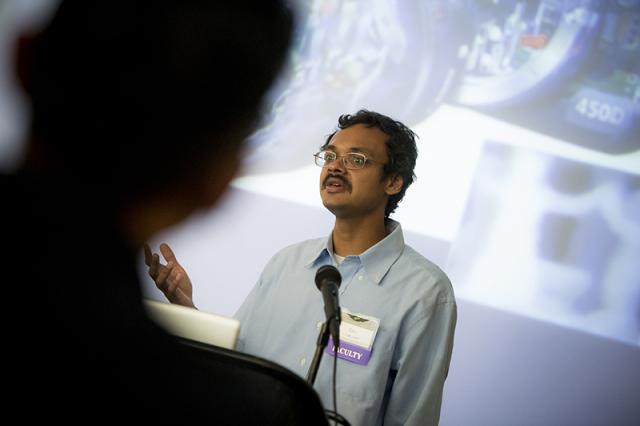
 The new Center for Visual Computing, an 'agile' research center based in the CSE department, had its official unveiling April 16 during the 2015 Research Expo of the Jacobs School of Engineering. Making it official, CSE Prof. Ravi Ramamoorthi (pictured) presented an outline of the center's current and future activities. He also confirmed that VisComp has lined up Sony as its lead sponsor, with additional partners Qualcomm, Pixar and Adobe. Ramamoorthi said the center hopes to grow membership to at least six companies from a variety of industries, including communication, entertainment, health, 3D printing and more. On the faculty side, VisComp includes Ramamoorthi as director, as well as CSE professors David Kriegman and Henrik Jensen, Qualcomm Institute research scientist Jurgen Schulze, and Zhuowen Tu, an expert in computer vision from Cognitive Science. "The motivation for this agile research center is that computer vision, graphics and imaging are still at a formative stage," said Ramamoorthi, "and they affect all areas of the computing stack from hardware to software to output, and they will have a major impact on our everyday lives."
The new Center for Visual Computing, an 'agile' research center based in the CSE department, had its official unveiling April 16 during the 2015 Research Expo of the Jacobs School of Engineering. Making it official, CSE Prof. Ravi Ramamoorthi (pictured) presented an outline of the center's current and future activities. He also confirmed that VisComp has lined up Sony as its lead sponsor, with additional partners Qualcomm, Pixar and Adobe. Ramamoorthi said the center hopes to grow membership to at least six companies from a variety of industries, including communication, entertainment, health, 3D printing and more. On the faculty side, VisComp includes Ramamoorthi as director, as well as CSE professors David Kriegman and Henrik Jensen, Qualcomm Institute research scientist Jurgen Schulze, and Zhuowen Tu, an expert in computer vision from Cognitive Science. "The motivation for this agile research center is that computer vision, graphics and imaging are still at a formative stage," said Ramamoorthi, "and they affect all areas of the computing stack from hardware to software to output, and they will have a major impact on our everyday lives."
Under the banner of "visualizing the way we capture, image and display the visual world," Ramamoorthi spelled out a three-part research agenda for the center: mobile visual computing and digital imaging; interactive digital (augmented) reality (to blend real and virtual scenes seamlessly in real time); and computer vision to understand people and their surroundings, from the individual- to the city-level. "We're witnessing the coming of age of computer vision, where every mobile phone has a camera and is doing fairly complicated processing based on a face detector," said Ramamoorthi. "Every mobile phone will also have access to Internet-scale visual databases, so we can enable semantic understanding of people's gestures, habits and similarities." He showed evidence that computer vision can be used to scan a crowd to detect "tribes" of people with like interests, such as bikers or surfers.
 The VisComp director spelled out some of the innovations that are rapidly changing photography and imaging, notably with virtual-reality devices such as the Oculus Rift, and perhaps more importantly, in the current commercialization of full 4D lightfield cameras, passive devices that capture the entire field of light, so that a photographer can capture an entire scene and choose later which angle, or what part of the image to refocus on. Light-field can also potentially be used to reconstruct three-dimensional (3D) scenes, one of the hottest new areas of interest that is pushing 3D from Hollywood down to the level of the mobile phone. "This enables a number of 3D applications," explained Ramamoorthi. "You can reconstruct 3D surfaces and couple it with the 3D printing industry to create an entire pipeline of 3D capture - just from the capture of a single shot image."
The VisComp director spelled out some of the innovations that are rapidly changing photography and imaging, notably with virtual-reality devices such as the Oculus Rift, and perhaps more importantly, in the current commercialization of full 4D lightfield cameras, passive devices that capture the entire field of light, so that a photographer can capture an entire scene and choose later which angle, or what part of the image to refocus on. Light-field can also potentially be used to reconstruct three-dimensional (3D) scenes, one of the hottest new areas of interest that is pushing 3D from Hollywood down to the level of the mobile phone. "This enables a number of 3D applications," explained Ramamoorthi. "You can reconstruct 3D surfaces and couple it with the 3D printing industry to create an entire pipeline of 3D capture - just from the capture of a single shot image."
"I believe the progress we will make in these three themes," he concluded, "have the potential to transform the way we interact with computers and, indeed, how we live our lives."
[Photos by Erik Jepsen/UC San Diego Publications]

